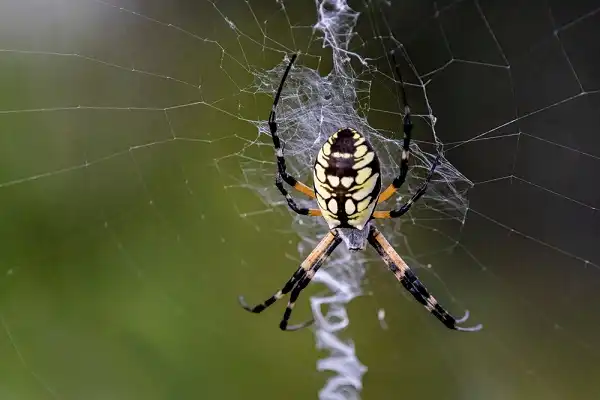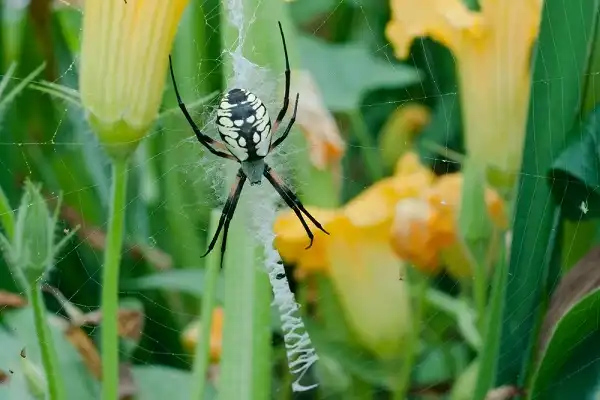Are you a fan of spiders? Have you ever noticed the Writing Spider (Argiope aurantia) among their web-building peers? This species can be found in gardens, fields, and woodlands in North America. It is easily recognizable by its large size and striking yellow and black colors – plus those thick stabilimenta it weaves into its webs! In this blog post, we will discuss the Writing Spider’s unique behaviors and physical features as well as some interesting facts about this fascinating arachnid. So keep reading to learn more about one of nature’s most brilliant creations!

Writing Spider Description
The Writing Spider is a large, brightly colored arachnid that is easily recognizable by its distinctive black and yellow markings. It is found in gardens, fields, and woodlands throughout North America and is a popular subject for nature enthusiasts and photographers due to its striking appearance and unique behaviors. Another unique aspect of the Writing Spider is the thick stabilimenta it weaves into its webs. These structures are composed of zigzag patterns of silk and are thought to help strengthen the web and attract prey. Interestingly, different individuals of the same species can create different types of stabilimenta, indicating a high degree of individual variation in behavior and web-building techniques.
Writing Spider Habitat
The Writing Spider is a widely distributed species that can be found in gardens, fields, and woodlands throughout North America. They thrive in warm and humid environments, with optimal temperatures ranging from 20-30°C. These spiders typically build their webs in open areas, such as meadows, along streams, and even in backyards. Writing Spiders are particularly prevalent in the southeastern United States, where they are known to frequent pine forests and proximity to water sources. They are also known to inhabit agricultural areas, such as cotton fields, where they can feed on common agricultural pests. Despite their seemingly ubiquitous presence, the population of Writing Spiders can be negatively affected by habitat destruction and pesticide use. The destruction of their natural habitats and the use of pesticides can lead to a decline in their prey populations and, as a result, a decrease in the spider population itself.
Writing Spider Diet
The Writing Spider is a predatory arachnid that feeds on a range of insects and other small invertebrates. Being a carnivorous creature, the Writing Spider makes use of its webs to capture prey. And due to its large size, the Writing Spider’s diet can include a diverse range of insects, such as beetles, grasshoppers, and even wasps. One unique aspect of the Writing Spider’s diet is its ability to selectively prey on certain types of insects that are more abundant in its environment. For instance, in agricultural areas such as cotton fields, the Writing Spider takes advantage of crop pests such as bollworms and stink bugs. This helps control pest populations, making the Writing Spider a valuable ally to farmers.

Writing Spider Size
The Writing Spider is a majestic creature that is known for its large and striking appearance. It is a member of the orb weaver family and can grow up to 2 inches in length, with females being bigger than males. The female Writing Spider boasts a distinctively patterned yellow and black abdomen that can measure over an inch in diameter. Its legs are covered with fine hairs that assist in the capture of prey. Despite their alarming size and appearance, Writing Spiders are relatively harmless to humans. Their venom is not dangerous to people, although individuals with allergies or sensitivities to insect stings may experience some discomfort or swelling at the bite site. Nevertheless, it is always wise to exercise caution and avoid handling them directly to minimize the risk of being bitten. The size of Writing Spiders can vary depending on their location and habitat. In areas with abundant food and favorable environmental conditions, they tend to grow larger. Moreover, the size of Writing Spiders also varies between males and females, with the latter being on average 30% larger than males. Apart from its impressive size, the Writing Spider is also renowned for its intricate web structure. The web is circular and can be up to 2 feet in diameter.
Writing Spider Lifespan
The lifespan of the Writing Spider varies depending on factors such as habitat and climate. In favorable conditions, they can live for up to a year or more. Adult females tend to have longer lifespans than males, as they have to invest more time and energy in producing eggs. During their lifespan, Writing Spiders undergo several stages of development, which involve shedding their skin and changing their appearance. After hatching from their eggs, they spend several weeks as spiderlings, during which they remain within the protection of their egg sac. As they mature, they begin to build their webs and hone their hunting skills, eventually becoming adults. One of the critical factors that affect the lifespan of Writing Spiders is the availability of food. During periods of scarcity, they may die young, whereas, in areas where food is abundant, they may live longer. In addition, Writing Spiders are susceptible to predation and may fall victim to birds, lizards, and other predators.
Writing Spider Behavior
Writing Spiders are fascinating creatures that exhibit a wide range of complex behaviors. In addition to web construction, Writing Spiders engage in other behaviors to ensure their survival and reproductive success. For example, males often perform elaborate courtship dances to attract females. These dances involve intricate movements and can last for several hours. Once a male has successfully courted a female, he will often die soon after, having fulfilled his reproductive role. Females, on the other hand, have a much longer lifespan and are responsible for producing and caring for their offspring. Writing Spiders lay their eggs in a silk sac, which they guard and protect until the spiderlings hatch. The mother will remain with her offspring for several weeks, feeding and protecting them until they are old enough to fend for themselves. While Writing Spiders are not typically aggressive toward humans, they can become defensive if provoked or handled roughly. It is always best to exercise caution when observing these fascinating creatures in the wild and to avoid disturbing their webs or getting too close.

Writing Spider Speed
Writing Spiders are slow-moving creatures that rely heavily on their webs for protection and to capture prey. While they can move quickly when necessary, their usual pace is quite leisurely. Writing Spiders typically travel up to 0.25 meters (1 foot) per second when searching for food or constructing a web. This is significantly slower than other species of spiders, such as Wolf Spiders, which can reach speeds of up to 1 meter (3 feet) per second. It’s important to note that Writing Spider speed may vary depending on environmental factors and the availability of food sources. For example, during periods of scarcity, Writing Spiders may move faster in order to increase their chances of finding sustenance. Conversely, if there is an abundance of prey in their vicinity, Writing Spiders may slow down and take their time when searching for food. Overall, the slow speed of Writing Spiders is a reflection of their specialized adaptation to a particular lifestyle. By sacrificing speed in favor of stealth, these spiders are able to maximize the efficiency of their webs and capture more prey than species that rely on quick bursts of activity. In this way, Writing Spiders demonstrate the incredible diversity and adaptability of arachnids.
Writing Spider Hunting
Writing Spiders are skilled hunters that rely on their webs to capture prey. They carefully spin intricate webs that are strategically placed to maximize their chances of a successful catch. The webs are made of unique silk that is strong, elastic, and sticky. When a fly, moth, or grasshopper lands on the web, the Writing Spider feels the vibrations and rushes to investigate. Once it detects its prey, the spider approaches it slowly and cautiously to avoid any sudden movements that may scare it away. The Writing Spider then uses its legs to wrap the prey in silk, immobilizing it and preventing it from escaping. It then injects venom into the prey, which not only subdues it but also starts the process of digestion.
Interestingly, Writing Spiders are known to adjust the amount of venom they inject based on the size and strength of their prey. Larger prey requires more venom, while smaller prey requires less. The process of wrapping and injecting prey can take some time, and during this time, the Writing Spider is vulnerable to predation. Therefore, it’s essential for the spider to move quickly and efficiently to minimize the risk of being caught off guard. Writing Spiders are also known to be intelligent hunters that can adapt their hunting strategies based on their environment and prey. For instance, they may adjust the location or design of their webs to catch a specific type of insect or compensate for a change in wind direction or humidity.
Writing Spider Reproduction and Life Cycle
In addition to their impressive hunting skills, Writing Spiders are also known for their complex reproductive strategies. Unlike other arachnids that lay eggs and leave them to fend for themselves, Writing Spiders take care of their young ones until they reach maturity. Writing Spider mating usually occurs in the early summer months and is preceded by courtship displays involving body posturing and touching. The female then produces an egg sac filled with up to 1,100 eggs which she attaches to a web or vegetation. She guards this egg sac until the eggs hatch into spiderlings (also called nymphs) three weeks later. The newly hatched spiderlings remain near the egg sac for several days as they molt and grow larger.

Conclusion
Writing Spiders are remarkable creatures that can move quickly and adapt their behavior to survive. Their speed is influenced by many factors, including age, environment, and the need to avoid or catch prey. Writing Spiders also exhibit incredibly intelligent hunting behavior, using their webs to capture insects with precision and patience. By studying their behavior and working to protect their habitats, we can continue to learn from these amazing animals.
Frequently Asked Question


